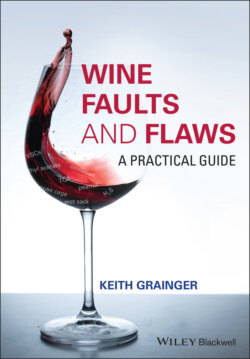Читать книгу Wine Faults and Flaws - Keith Grainger - Страница 22
1.8.3 Odour Activity Values
ОглавлениеThe levels at which a fault compound in wine is detected and identified will very much depend upon the wine matrix. Additionally, there may be multiple compounds responsible for an off‐aroma or flavour in a wine, and the threshold for determining the multiplicity of these may differ from that of the individual components. This is particularly so in the case of the compounds metabolised by yeasts of the genus Brettanomyces, as discussed in Chapter 4. Depending upon the fault in question, sensory detection thresholds for fault compounds may be measured in concentrations of milligrammes per litre (mg/l), which equates to parts per million (ppm), microgrammes per litre (μg/l), which equates to parts per billion (ppb), or even nanogrammes per litre (ng/l), which equates to parts per trillion (ppt). The human nose can actually detect some odours at levels of picogrammes per litre (pg/l) equivalent to parts per 1000 trillion, and possibly and incredibly at concentrations measured in femtogrammes per litre (fg/l). A femtogramme is 0.000 000 000 000 001 of a gramme! Only volatiles smell – we cannot smell most wine acids, with the exception of the volatile acids (mainly acetic acid).
Usually the greater the concentration of a compound, particularly if above detection threshold, the more it will impact upon odour. Accordingly some researchers consider ‘odour activity values’ (OAVs), which may be defined as the concentration of a compound present in a matrix divided by the ODT for that compound in that specific matrix [13]. Of course, the higher the OAV the more the compound will usually also impact the palate or taste profile, bearing in mind that most of the taste of a wine is derived from retronasal sensations. Of course, the strength of an odour is not simply a matter of is OAV, and strong odours can mask weaker odours.
